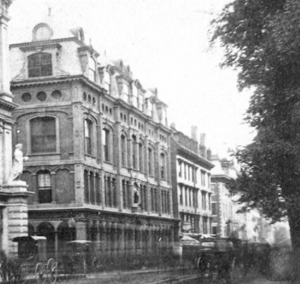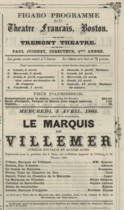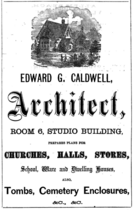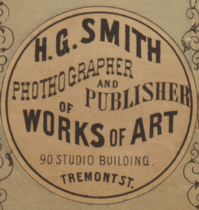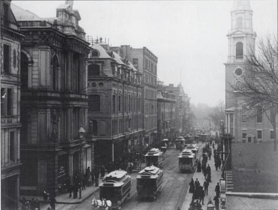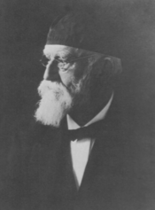Studio Building (Boston, Massachusetts) facts for kids
The Studio Building (1861–1906) was a famous building in Boston, Massachusetts. It was located on Tremont Street. This building was a lively place in the 1800s. It had many art studios, theater groups, and other businesses. People called it "the true Bohemia of Boston" because artists and writers loved to meet there. Many famous people worked in the Studio Building. These included artists like William Morris Hunt and William Rimmer. Sculptors like Martin Milmore also had studios there.
Contents
A Look Inside the Studio Building
Artists' Creative Spaces
From 1861, the Studio Building stood next to the Horticultural Hall. It was a large brick building with four floors. The ground floor had big stores selling things like sewing machines and clocks. The floors above were full of artists. Painters, engravers, and designers all worked there.
The Studio Building was like a busy "hive of artists." It was the main place for artists in Boston. They often held open houses where the public could visit. Besides artists, many music and language teachers worked there. Some rooms were even used as apartments. In 1863, Sophia Peabody Hawthorne visited. She saw many artworks, including a statue and portraits.
Learning Art from Masters
Starting in 1861, artist William Rimmer taught anatomy classes in Room 55. He was a very inspiring teacher. Many famous artists learned from him. These included John LaFarge and Daniel Chester French. Rimmer's classes were special. He taught about the human body for art. This was new and important in the United States. He drew amazing pictures on the blackboard. His drawings often showed figures with wings or in fancy armor. One of his students was May Alcott, who studied sculpture with him.
The studio of William Morris Hunt was also a big draw. People loved to visit his "receptions." His famous painting, The Bugle Call, was shown here. He also created The Drummer Boy drawing. This drawing was very popular. It had the message "To arms! To arms!" This message fit the patriotic mood of the time.
The Tremont Theatre
The Studio Building also had a theater called the Tremont Theatre. It opened in 1863. It was first managed by Mrs. Jane English. Many different shows were performed there. These included ballets and plays. Even though the shows were good, the theater did not do well. It later became a hall for walking races. By 1892, it was used as a carpet store.
Some of the performances included:
- "Le Rue's great war show!"
- Theatre Francais, which showed French plays.
- The Ticket-of-Leave Man by Tom Taylor.
- The Holman Opera Troupe, a family of singers.
- Minstrel shows by groups like Morris Brothers.
The 1906 Fire
In December 1906, a big fire happened in the area. The fire caused a lot of damage. Luckily, the flames were mostly kept to the Studio Building itself.
Images for kids
Tenants
- American Art Gallery
- Joseph Ames
- Miss M.K. Baker, artist
- E.M. Bannister, artist
- E.T. Billings, artist
- Edward Brackett
- Miss M.A. Bradford, artist
- Mrs. E.H. Brainard, artist
- Miss H.L. Brown, artist
- J. Appleton Brown, artist
- E.C. Cabot, architect
- Edward G. Caldwell, architect
- Miss E.M. Carpenter, artist
- William Carl, artist
- Miss A.E. Chandler, artist
- F. Myron Clark
- J.G. Cloudman, artist
- George A. Clough, architect
- Darius Cobb, artist
- Theodore E. Colburn, architect
- Henry Cook, artist
- Charles Copeland, artist
- J.C. Crossman, artist
- George L. Crosby, artist
- Cummings & Sears, architects
- Cyrus E. Dallin, artist
- Thomas W. Dewing, artist
- T.C. Doane
- John Donoghue, artist
- Morris Dorr, architect
- Grace Dow, artist
- Frank Duveneck, artist
- B.F. Dwight, architect
- Educational Committee for Freedmen
- L.D. Eldred, artist
- William R. Emerson, architect
- Miss M.M. Emery, artist
- Fabronius, artist
- A.C. Fenety, artist
- F.M. Fenety, artist
- Beatrice V. Folsom, artist
- Bradford Freeman, artist
- Francis Seth Frost
- Edmund H. Garrett, artist
- Ignaz Gaugengigl, artist
- S.L. Gerry
- Ellen L. Gilbert, artist, educator
- James Gilbert, artist
- Abbott Graves
- James R. Gregerson, architect
- S.W. Griggs, artist
- Louis K. Harlow, artist
- George F. Higgins, artist
- S.P. Hodgdon, artist
- Mrs. Horton, artist
- William Morris Hunt
- Phoebe A. Jenks, artist
- N.T. Johnson, artist
- D.C. Johnston and T.M.J. Johnston, artists
- Earnest Kuhn, artist
- Walter F. Lansil, artist
- A.W. Latham, artist
- Edmonia Lewis
- L.K. Long, artist
- W.P.P. Longfellow, architect
- G.A. Loring, artist
- Miss E.P. Mann, artist
- Marshall & Co., photographs
- Mrs. M.C. McGurk, artist
- H.W. Merrill, artist
- Samuel S. Miles, artist
- Martin Millmore, sculptor
- B.R. Morse, artist
- George C. Munzig, artist
- P. Nefflen, artist
- New England Loyal Publication Society (related to the Loyal Publication Society
- Jessie Noa, artist
- F. Evelyn Nute, artist
- Alfred Ordway, artist
- H. Winthrop Peirce, artist
- S.E. Perkins, artist
- Miss M.A. Platt, artist
- B.C. Porter, artist
- C.W. Reed, artist
- Miss H. Reed, artist
- Mrs. E.S. Remick, artist
- J.F. Reynolds
- William Rimmer, sculptor
- Thomas Robinson, artist
- S.W. Rowse, artist
- L.A. Schirmer, artist
- G.W. Seavey, artist
- Frank H. Shapleigh, artist
- Anna H. Silloway, artist
- T.S. Slafter, artist
- H.G. Smith, photographer, publisher
- George Snell, architect
- Miss Southwick, artist
- Charles E. Stetfield, artist
- Miss S.C. Stetson, artist
- Frederick T. Stuart, artist, c. 1902
- Miss F.W. Tewskbury, artist
- Jerome Thompson, painter
- John D. Towle & Son, architects
- Henry Van Brunt and William Robert Ware, architects
- Herman Vogel, artist
- Seth Morton Vose, gallerist
- Lilian Walker, artist
- Florence I. Webber, artist
- George A. Weeden, artist
- Fred D. Williams, artist
- Joseph P. Woodbury, "inventor"
- Elizabeth Wyer, artist


